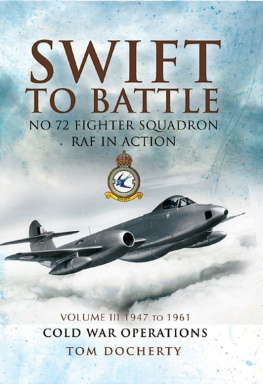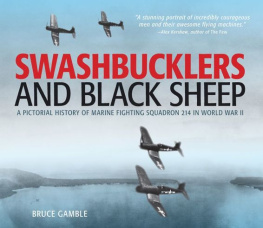Heroes of theRAF
No.43Squadron
by
LeonardJames

Published by Bretwalda Books atSmashwords
Website : Facebook : Twitter
Copyright Rupert Matthews 2011
This ebook is licensed for your personalenjoyment only. This ebook may not be re-sold or given away toother people. If you would like to share this book with anotherperson, please purchase an additional copy for each person. Ifyou're reading this book and did not purchase it, or it was notpurchased for your use only, then please return to Smashwords.comand purchase your own copy. Thank you for respecting the hard workof this author.
ISBN 978-1-907791-38-3
Contents
---------
When I was a smallboy my father gave me a set of cigarette cards. He had been in theRAF during the War and like all small boys in the 1960s I madeAirfix Spitfires and watched movies such as Angels One Five ontelevision. So I pored over the cigarette cards, read the pottedsquadron histories on the back and stuck them all into ascrapbook.
There was one cardthat puzzled me. It showed what I took to be a chicken. I knew allabout chickens because my Great Aunt Hilda kept a few in her largerural garden. I just could not work out why any heroic RAF squadronwould want a chicken as their official badge. It was a puzzle Icould not solve. Years later I realised that what I had taken to bea chicken was a fighting cock and a most worthy symbol it was forthe squadron concerned. No.43 has long been one of the RAFspremier squadrons, and its longevity is as impressive as its combatrecord.
No.43 has beenformed, disbanded and reformed several times since it wasestablished in 1916. Most recently it was stood down on 13 July2009, though there are plans to reform it as a Typhoon Eurofightersquadron. Given the parlous state of the nations finances as Iwrite this there is some doubt if the new squadron will form asexpected. We shall see. What cannot be doubted is the glorioushistory of the squadron, its men and machines.

----------
The GreatWar
On 15 April 1916the Royal Flying Corps base at Stirling, Scotland, was home toNo.18 Reserve Squadron. The squadron, in common with most reserveand training units at the time, was equipped with a bewilderingvariety of aircraft types. But the RFC, like all branches of theBritish Army, was then gearing up for the widely expected bigpush that everyone expected in the summer of 1916. That was totake the form of the Battle of the Somme, during which the RFCwould establish and maintain air superiority over the Britishsection of the Western Front, driving the Germans from the skiesover the trench systems.
It was clear thatevery man and machine was going to be needed and the orders wentout for an expansion of the RFC. No.18 Reserve Squadron wastherefore converted to be No.43 Squadron of the RFC. For the timebeing the mixture of aircraft was retained, but as the autumnbecame the winter, No.43 Squadron was re-equipped with a scout (orfighter) aircraft called the Sopwith 1 1/2 strutter.

By this date thevarious roles of military aircraft were becoming fairly wellestablished. When aircraft had first gone to war in 1914 they hadbeen used exclusively as reconnaissance or scout aircraft. Thepilots had flown out ahead of the ground armies to try to spotenemy troops, then flew back to base to make their reports. Withinmonths some pilots began dropping explosive devices, soon to bedubbed bombs, or shot at other aircraft in the hope of bringingthem down. By late 1916 there were specialist bomber aircraft,while two seater reconnaissance aircraft with radios were spottingfor artillery and seeking out enemy ground formations andstructures. As the assorted tasks were taken up by specialistaircraft and squadrons, the original scout squadrons were graduallyleft with the task of attacking enemy aircraft and became de factofighter squadrons, though they generally continued to be termedscouts.
The Sopwith 1 1/2strutter had been designed in December 1915 to be a long range,offensive patrol scout with the ability to carry a few light bombsin case some useful target was spotted by the pilot. The aircraftwas officially named the Land Clerget Tractor, but gained itsubiquitous nickname from the layout of the struts that joined andbraced the upper and lower wings. The aircraft had large fueltanks, that gave it the ability to stay in the air for almost fourhours, then a very good time indeed, and so to penetrate far beyondGerman lines.

The key feature ofthe aircraft was its armament. The pilot sat at the front, justbehind the engine and operated a .303in Vickers machine gun thatshot forwards through the arc of the propeller. Some of the earlyinterrupter gears did not work terribly well and it was not unusualfor a Sopwith pilot to shoot his own propeller off. Behind thepilot sat an observer in a separate cockpit. He was armed with a.303in Lewis machine gun that was attached to the thenrevolutionary scarf ring fitting that allowed the observer to swinghis gun quickly and easily through a wide arc, making his firenimble and effective.
In January 1917No.43 Squadron moved out to France with their Sopwiths and enteredcombat. One of the men of No.43 was not destined to stay with thesquadron for very long. Captain Alan Scott was one of the worstpilots in the squadron. During training he crashed more than anyother student, and managed to break both his legs. Nevertheless, hepersevered and qualified as a pilot. Despite his lack of skill, heproved to be an inspired leader of men and was soon a flightcommander. He proved to be particularly talented at navigation andso was sent on missions to photograph locations behind Germanlines. He shot down three German aircraft with No.43, then was shotdown himself but walked away from the crash uninjured. In March hewas given command of No.60 Squadron and left No.43. He was shotdown again in July and this time wounded badly enough to be sentback to Britain. He then took up a pilot training post - with oneof his pupils being Winston Churchill. Scott survived the war, butdied in the 1920s.
On 7 March thesquadron welcomed to its ranks a man who managed to combine being anewly qualified pilot with having already shot down 10 Germanaircraft. Frederick Libby was an American from Colorado who hadvolunteered to be an ambulance driver in the Canadian Army whenWorld War I broke out. In 1916 he tired of his medical role andinstead volunteered for the RFC. He trained as an air gunner, andit was while flying as a gunner that he shot down his 10 Germans.He thus became the first American ace of all time. Havingqualified as a pilot, Libby was posted to No.43 Squadron where heshot down two more aircraft. When the USA joined the war, Libby wastransferred to the US Army and went back to America to train newaircrew, give morale boosting talks and join the Liberty Loandrive. He often said, when training air gunners, that Aerialgunnery is 90 percent instinct and 10 percent aim. After the warLibby went into the oil business and he survived until 1970.





















